You know that wonderful experience when you’ve written a whole blog post and attached pictures? Really quite a rewarding experience.
But do you know the experience of that whole blog post disappearing for No Good Reason and leaving you a Blank Page?
That is not a rewarding experience.
Nevertheless, I shall persevere and WRITE THIS THING OVER AGAIN.
Where were we?
Ah yes. Weddings. The wonderful event of the union of one human to another. Weddings are a huge deal in most cultures, and the same is certainly true in Indonesia.
Now, hailing from good ole ‘murica, I have always been familiar with the whole white dress, walking down wedding aisle, wedding rings, throwing bouquets, receptions, the works.
For some strange reason, it never really occurred to me that weddings differ based on culture, location, and whatnot. Especially the whatnot.
What does that mean?
Indonesian weddings are vastly different from western/American weddings!
“How so?” You may ask.
Well, let me take you through the process.
The wedding happens in four stages.
- The Week Before Luncheon
- The Private Wedding Ceremony
- The Random Wedding Eve Party
- The Public Wedding Ceremony
Unless you are close family, it is unlikely that you will go to all four stages. Luckily for me, I have been to all four stages because I have had the privilege of going to three weddings. So, let’s do this step by step:
The Week Before Luncheon
The Week Before Luncheon is for family only. I attended the WBL for my first wedding here. For this specific wedding, it happened at the bride’s house, and I believe that it was only the bride’s extended family. My host dad was somehow related to the bride.
Now what goes on at the WBL?
One word: Food.
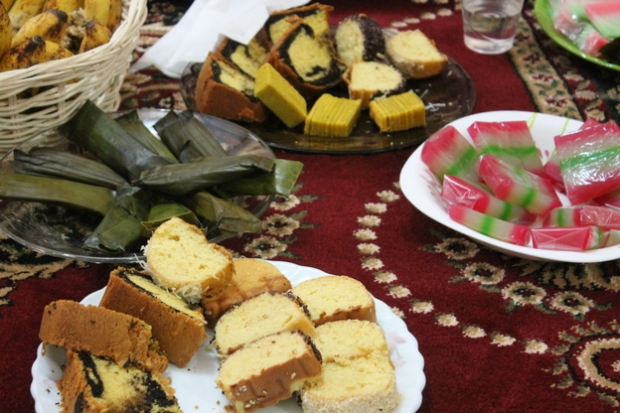
People make food, there are snacks set out for people to eat, and then there is the food that makes up lunch.
I suppose that there was also socializing.

The bride is the second to the right.
The Private Wedding Ceremony
This stage is the literal wedding. This wedding is only for the closest family. Out of the three weddings I went to, I was only invited to one PWC, and that was to my third wedding.
The PWC normally takes place at someone’s home or something similar.
Before we go through the wedding, let’s talk about the dress.
Each region and tribe of Indonesia has different foods, traditions, and clothes. The same applies with marriage clothes.
For this PWC, the couple wore Padang clothes, since one of the four parents was from Padang.
The PWC began by the mother-in-law giving the groom a flower necklace.

The groom then went and sat with the fathers and some officials. They all did the official wedding paperwork, and then symbolically (and literally) held hands. From the other room, the bride asked her father for forgiveness (via a microphone). After that is over, she enters the room and sits by her groom.
After finishing touches to the official documents, the bride and groom put rings on one another.
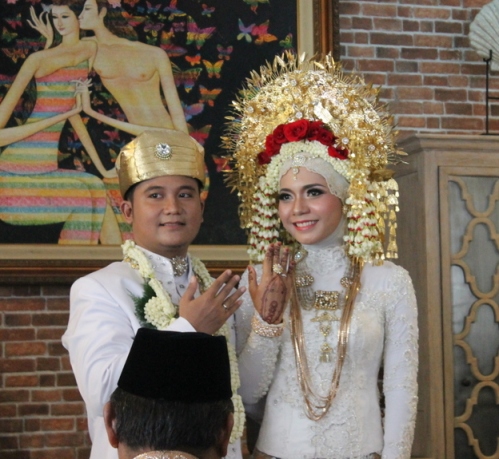
Showing off the bling.
They also showed off their new identification documents (marriage status!).
Furniture was then shoved out of the way and parents sat on opposite sides of the room. The bride and groom asked their parents and their new in-laws for forgivingness through saliming (head to hand) and embraces.


An imam/sort of Muslim leader was invited in and started singing portions of the Qur’an (forgive me for not knowing what parts or their significance). After that, everyone prayed briefly.

And that was the end to the literal wedding ceremony.
After that point, there were pictures,

and of course, food.

The Random Wedding Eve Party
As the title of the stage states, the RWEP takes place in the evening on the same day as the PWC. The RWEP I went to was for the same bride as pictured from the WBL.
I am not really sure what the purpose of this stage was. All that happened was people gathered, ate dinner, and took photos.

The Public Wedding Party
This is the party stage of the wedding process. The PWP is the part of the wedding that everyone comes to. If the venue is big enough and the family rich enough, this is the party that around 2,000 people can come to.
It takes place in a large room.
There is a roped off area with tables and food; this is an area only for the intermediate family of the bride and groom. For everyone else, there are a couple of chairs around the edges of the room, and two big food tables on each side of the room. At the front of the room is a flowery dais with a love seat in the middle and four separate chairs off to the sides.
The lack of chairs and tables is what makes the vast amount of guests possible. They just stand around and fill the empty space.
Remember how we talked about tribes and regional differences? Well, depending on what region or tribe the wedding is, the PWP differs.
Wedding #1 – Central Java
This is the wedding of the bride whose WBL and RWEP I went to.
They had a symbolic marriage ceremony (since they were already married).
The parents walked down the aisle from opposing directions and greeted one another.

The bride then came in and stood on the flowery dais.
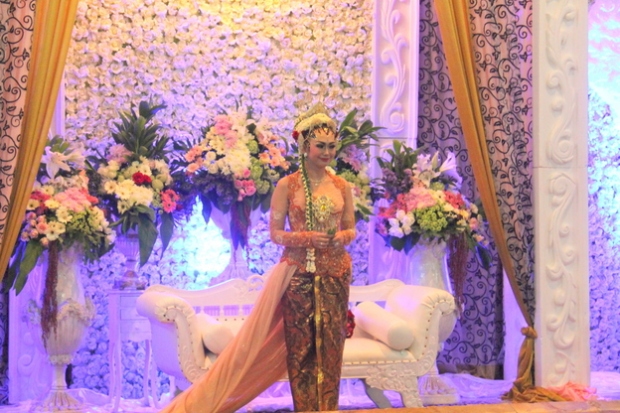
She was escorted down the aisle and to her husband. They were then placed side by side and pulled down the aisle with a shawl. One of the mothers backed them.

They sat on the love seat, then stood up. The bride’s father sat on the middle of the love seat and the couple sat down on his lap.

According to him, whoever weighed more would be the dominant one in the relationship (since we all know that weight is a highly scientific way of measuring dominance).
Who weighed more?
Well, I’m not sure of the official verdict, but having seen how tiny the bride was, I’d wager it was the groom.
They asked forgiveness from their parents.

They walked up and down the aisle a couple more times, asked forgiveness from their parents, and then took pictures with the guests.

The guests are then allowed to eat and socialize, but you must also give your good wishes to the newlyweds and their parents on the dais.
Wedding #2 – Sunda (West Java)
This wedding was of the daughter of my grandma’s neighbor, so this was the only part of her wedding I attended.
She and her husband walked down the aisle together.
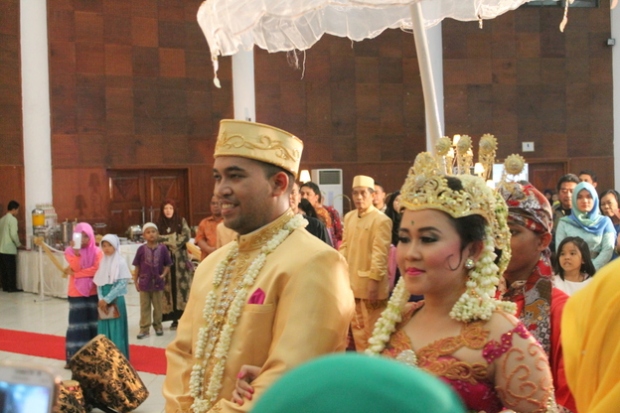
They sat on the dais on the front of the room.
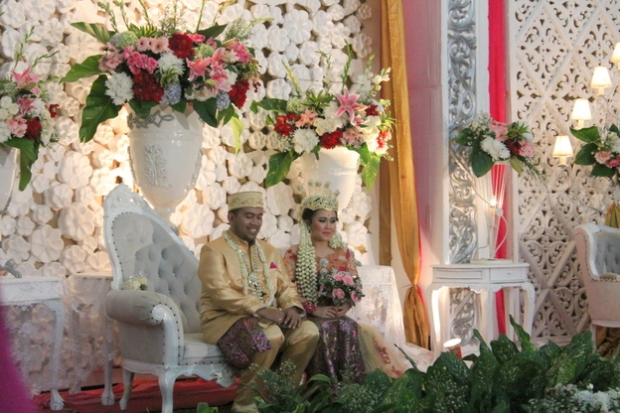
And watched, along with everyone else, some dancers dance a traditional Sunda dance.

I’m not actually sure what happened after this point, as my host family wanted to go straight to the food before everyone else did.
(Even though it turned out that everyone else had the same idea; the lines had already formed by the time we got to the food tables.)
Wedding #3 – Palembang
This was the wedding of the bride whose PWC I attended. Her PWC was Padang style, but her PWP was Palembang style, after another one of the parents. As a result, all the clothes and styles were different from the day before.
Six dancers preceded the married couple.
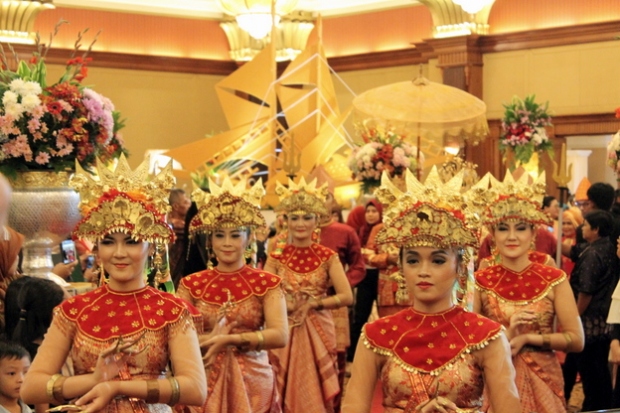
And then there was the newlyweds.

I was very impressed with their attire. It was incredibly ornate and those headpieces were probably heavy. Then again, the Padang headpiece probably was too.
The couple went onto the dais, and then down onto the floor in front of it. The dancers guided the bride to a plate of flowers.
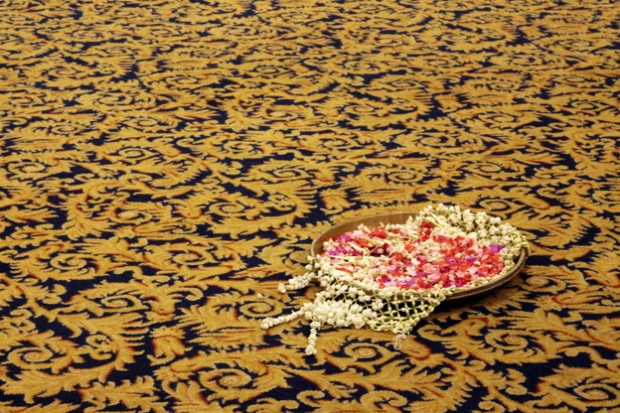
They helped her step onto it and then put “bird claws” on her fingers.

Then the dancers fell into formation around the bride and began to do a traditional Srivijaya dance (the empire whose capital used to be Palembang).
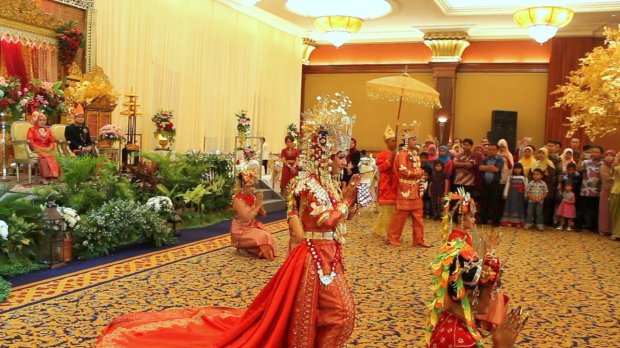
After the dance was over, the dancers took the claws off the bride’s fingers, helped her off the plate of flowers, and back onto the dais. Then, like the two weddings before them, they took pictures and greeted guests.
And that concludes the three weddings I’ve been to. Pretty exciting, huh?
What are your country’s wedding traditions?
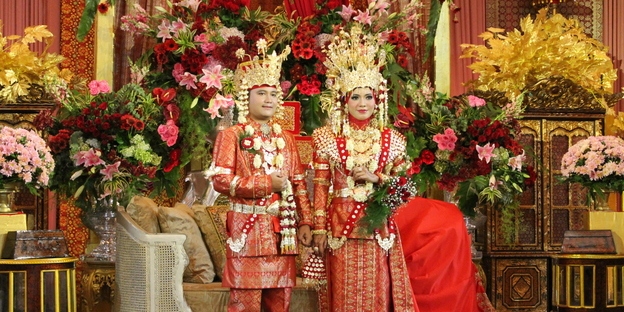

Very cool post, Ruth!! Thanks for taking the time to put it all together again after you lost it 🙂
LikeLike
nice:)
LikeLike
make more
LikeLike
Hello! I am Yudhis, I am an Indonesian and I was an exchange student myself 2012/2013. The past couple days I have been reading your blog, it makes me miss Indonesia too much and I am glad that you got to visit places in Indonesia because not all exchange students get that opportunity.During my exchange year, I was in a small town (so small, the population was around 600 people) in Minnesota, the first month I thought I was not going to make it through until at the end of the program but I survived thru the last day I was in MN (I was bawling the day I had to go back to Indonesia). Somehow I can relate to your experiences in Indonesia, how different the cultures are between home and Indonesia (in my case is in reverse).
I read your writing about Martabak Manis and THAT IS MY FAVE, and actually there is a mix powder where you only need to add water and egg to it and you can make it on the pan (they have it here in LA) and you add topings to it. let me know if you want some I can try to find some of the mix for you send it to you when you are back from Indo! Cheers!
LikeLike